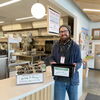Processing Your Payment
Please do not leave this page until complete. This can take a few moments.
- News
-
Editions
-
- Lists
-
Viewpoints
-
Our Events
-
Event Info
- Women's Leadership Forum 2025
- On the Road with Mainebiz in Bethel
- Health Care Forum 2025
- On The Road with Mainebiz in Greenville
- On The Road with Mainebiz in Waterville
- Small Business Forum 2025
- Outstanding Women in Business Reception 2025
- On The Road with Mainebiz in Bath
- 60 Ideas in 60 Minutes Portland 2025
- 40 Under 40 Awards Reception 2025
- On The Road with Mainebiz in Lewiston / Auburn
- 60 Ideas in 60 Minutes Bangor 2025
Award Honorees
- 2025 Business Leaders of the Year
- 2024 Women to Watch Honorees
- 2024 Business Leaders of the Year
- 2023 NextUp: 40 Under 40 Honorees
- 2023 Women to Watch Honorees
- 2023 Business Leaders of the Year
- 2022 NextUp: 40 Under 40 Honorees
- 2022 Women to Watch Honorees
- 2022 Business Leaders of the Year
-
-
Calendar
-
Biz Marketplace
- News
- Editions
- Lists
- Viewpoints
-
Our Events
Event Info
- View all Events
- Women's Leadership Forum 2025
- On the Road with Mainebiz in Bethel
- Health Care Forum 2025
- On The Road with Mainebiz in Greenville
- On The Road with Mainebiz in Waterville
- + More
Award Honorees
- 2025 Business Leaders of the Year
- 2024 Women to Watch Honorees
- 2024 Business Leaders of the Year
- 2023 NextUp: 40 Under 40 Honorees
- 2023 Women to Watch Honorees
- 2023 Business Leaders of the Year
- + More
- 2022 NextUp: 40 Under 40 Honorees
- 2022 Women to Watch Honorees
- 2022 Business Leaders of the Year
- Nomination Forms
- Calendar
- Biz Marketplace
Track star | Patricia Quinn, Northern New England Passenger Rail Authority
 Tim Greenway
Patricia Quinn, executive director of the Northern New England Passenger Rail Authority
Tim Greenway
Patricia Quinn, executive director of the Northern New England Passenger Rail Authority
NORTHERN NEW ENGLAND PASSENGER RAIL AUTHORITY
75 West Commercial St., Suite 104, Portland
Founded: 1995
Services: Operating the Downeaster train
Employees: Six, including Quinn
Annual operating budget: $15.2 million, 54% from ticket, parking and food sales
Contact: 780-1000
ww.amtrakdowneaster.com
As a child, Patricia Quinn did not play with toy trains, was not obsessed with locomotives and did not dream of becoming a train conductor.
“I knew nothing about the rail business, or how trains worked or the engineering side of it,” Quinn says about the day, 11 years ago, she applied for a job with the Northern New England Passenger Rail Authority, the Portland-based organization bringing back passenger rail to Maine. “When I started this job I had never ridden a train before.”
Now Quinn is a passenger-rail authority herself. As executive director of NNEPRA, Quinn is a widely recognized expert on developing passenger trains in rural markets. Despite coming into this business with zero industry experience, Quinn has made a profound, lasting impact on Maine’s transportation infrastructure and economy.
With her five-person staff, Quinn has turned the young Downeaster train between Boston and Portland into a viable, popular transportation mode. This past year, the Downeaster topped 500,000 annual passengers for the first time, and ridership grew 8%. Since 2005, ridership and revenue have grown by more than 100%.
More recently, Quinn led her organization through the painful experience of its first fatal crash when a truck driver collided with a train at a rail crossing in North Berwick. Quinn says while the loss of the driver’s life is tragic, many other things went right to keep everyone on the train safe.
Lots of things have gone right under Quinn’s leadership, such as NNEPRA’s monumental expansion of the Downeaster to Freeport and Brunswick, a $38 million construction project under way that’s being funded with a competitive $35 million federal grant.
Quinn grew up in Norwich, Conn., and graduated from Eastern Connecticut State University, then worked in the hotel business for seven years, eventually becoming general manager for the DoubleTree hotel in Portland.
Hired first by NNEPRA as a part-time consultant in 2000, Quinn started asking questions, such as, “How are you going to feed people on the train?” she says. “Inventory management, food service, customer service — there’s lots of similarities between this and the hotel business.” She was promoted to executive director in 2005.
Quinn says she’s always been driven to excel, a quality instilled in her by her mother, a housewife with high expectations for her children. Quinn’s father was an industrial plumber who worked on nuclear power plants and paper mills. “I’ve always believed if you’re going to do something, do it well. Otherwise don’t waste your time,” Quinn says, a philosophy she is passing on to her son and daughter, ages 19 and 16.
These days, she’s focused on whittling the travel time between Portland and Boston to just over two hours and adding two more daily round-trips for a total of seven. And she’s determined to make the Brunswick expansion a success, employing the same tactics she used with the Downeaster, such as marketing to pocket riderships of college students and professors, patients of city doctors, sports fans and shoppers. “We niche market,” Quinn explains. “We market by train, by target, to match people with trains.”
NNEPRA’s reputation for smart marketing and its quantification of the economic impact on station communities along the Downeaster route has helped the nationally lauded train compete for federal funds, according to Quinn. This year the train won $20.8 million in federal grants for track improvements.
For all her successes, Quinn admits she’s disappointed the train hasn’t developed faster, and acknowledges the critics who’d rather have a commuter train — something she wants as well — when there’s funding for it. “I wanted to make everyone happy,” Quinn says. “It was why I was in the hospitality business. But I can’t with this many people [invested in seeing trains revived]. And with trains being such a polarizing force, I had to learn to become a little more thick-skinned.”
Quinn is still not driven by a passion for trains, but rather a desire for change. “For the most part, I like being in the public sector and working for something other than your paycheck,” she says. “I do this job because [the train’s] an important mode of transportation and needs to be part of the national transportation system.”
IN HER OWN WORDS
What was the biggest challenge of your career? I learned to feel a sense of accomplishment for the first time when we were able to start the fifth route [between Portland and Boston] in 2008.
When did you know you'd made it? I'm not 100% sure some days that I have!
What advice do you wish you'd gotten early in your career? Be patient.
"I'll relax when... the train to Brunswick is up and running and there's a robust and consistent ridership. I'm not sure I'll relax, but I'll be more relaxed."
What was your "Haven't we moved beyond this" moment? This actually happens consistently. It's an ongoing educational process for people to understand what the [train] mode is all about, the funding is all about and the economics of the service.
DOWNLOAD PDFs
Women to Watch 2011: Patricia Quinn
See more of Patricia Quinn and Northern New England Passenger Rail Authority
Read more
A matter of degrees | Danielle Ripich, University of New England
Taking another tack | Beth Shissler, Sea Bags
Double duty | Colleen Hilton, VNA Home Health & Hospice
Mill right | Louise Jonaitis, Saunders Bros. at Locke Mills LLC









Comments